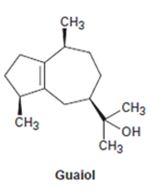
Concept explainers
a)

Interpretation:
At what positions the terpenoid guaiol will be labeled if isopentyl diphosphate and dimethylallyl diphosphate from which they are synthesized are isotopically labeled at the diphosphate bearing carbon atom (C1).
Concept introduction:
In the formation of terpenes every fourth carbon of one dimethylallyl phosphate (formed by the isomerization of isopentyl diphosphate) combines with the first carbon of the isopentyl phosphate molecule. Hence if the diphosphate bearing carbon is labeled, every fourth carbon in a terpene will be a labeled carbon.
To give:
The positions at which the terpenoid guaiol will be labeled if isopentyl diphosphate and dimethylallyl diphosphate from which it is synthesized are isotopically labeled at the diphosphate bearing carbon atom (C1).
b)

Interpretation:
At what positions the terpenoid sabinene will be labeled if isopentyl diphosphate and dimethylallyl diphosphate from which they are synthesized are isotopically labeled at the diphosphate bearing carbon atom (C1).
Concept introduction:
In the formation of terpenes every fourth carbon of one dimethylallyl phosphate (formed by the isomerization of isopentyl diphosphate) combines with the first carbon of the isopentyl phosphate molecule. Hence if the diphosphate bearing carbon is labeled, every fourth carbon in a terpene will be a labeled carbon.
To give:
The positions at which the terpenoid sabinene will be labeled if isopentyl diphosphate and dimethylallyl diphosphate from which it is synthesized are isotopically labeled at the diphosphate bearing carbon atom (C1).
Want to see the full answer?
Check out a sample textbook solution
Chapter 27 Solutions
Organic Chemistry
- In the decomposition reaction in solution B → C, only species C absorbs UV radiation, but neither B nor the solvent absorbs. If we call At the absorbance measured at any time, A0 the absorbance at the beginning of the reaction, and A∞ the absorbance at the end of the reaction, which of the expressions is valid? We assume that Beer's law is fulfilled.arrow_forward> You are trying to decide if there is a single reagent you can add that will make the following synthesis possible without any other major side products: 1. ☑ CI 2. H3O+ O Draw the missing reagent X you think will make this synthesis work in the drawing area below. If there is no reagent that will make your desired product in good yield or without complications, just check the box under the drawing area and leave it blank. Click and drag to start drawing a structure. Explanation Check ? DO 18 Ar B © 2025 McGraw Hill LLC. All Rights Reserved. Terms of Use | Privacy Center | Accessibilityarrow_forwardDon't use ai to answer I will report you answerarrow_forward
- Consider a solution of 0.00304 moles of 4-nitrobenzoic acid (pKa = 3.442) dissolved in 25 mL water and titrated with 0.0991 M NaOH. Calculate the pH at the equivalence pointarrow_forwardWhat is the name of the following compound? SiMe3arrow_forwardK Draw the starting structure that would lead to the major product shown under the provided conditions. Drawing 1. NaNH2 2. PhCH2Br 4 57°F Sunny Q Searcharrow_forward
- 7 Draw the starting alkyl bromide that would produce this alkyne under these conditions. F Drawing 1. NaNH2, A 2. H3O+ £ 4 Temps to rise Tomorrow Q Search H2arrow_forward7 Comment on the general features of the predicted (extremely simplified) ¹H- NMR spectrum of lycopene that is provided below. 00 6 57 PPM 3 2 1 0arrow_forwardIndicate the compound formula: dimethyl iodide (propyl) sulfonium.arrow_forward

 Introduction to General, Organic and BiochemistryChemistryISBN:9781285869759Author:Frederick A. Bettelheim, William H. Brown, Mary K. Campbell, Shawn O. Farrell, Omar TorresPublisher:Cengage Learning
Introduction to General, Organic and BiochemistryChemistryISBN:9781285869759Author:Frederick A. Bettelheim, William H. Brown, Mary K. Campbell, Shawn O. Farrell, Omar TorresPublisher:Cengage Learning Organic ChemistryChemistryISBN:9781305580350Author:William H. Brown, Brent L. Iverson, Eric Anslyn, Christopher S. FootePublisher:Cengage Learning
Organic ChemistryChemistryISBN:9781305580350Author:William H. Brown, Brent L. Iverson, Eric Anslyn, Christopher S. FootePublisher:Cengage Learning


